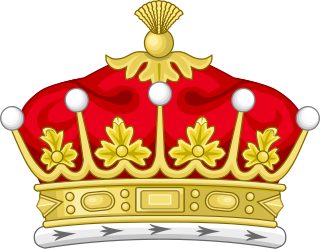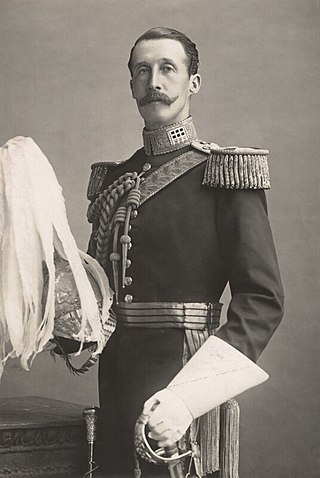
Earl of Derby is a title in the Peerage of England. The title was first adopted by Robert de Ferrers, 1st Earl of Derby, under a creation of 1139. It continued with the Ferrers family until the 6th Earl forfeited his property toward the end of the reign of Henry III and died in 1279. Most of the Ferrers property and the Derby title were then held by the family of Henry III. The title merged in the Crown upon Henry IV's accession to the throne in 1399.

Philip Henry Stanhope, 5th Earl Stanhope,, styled Viscount Mahon between 1816 and 1855, was an English antiquarian and Tory politician. He held political office under Sir Robert Peel in the 1830s and 1840s but is best remembered for his contributions to cultural causes and for his historical writings.

Viscount Cobham is a title in the Peerage of Great Britain that was created in 1718. Owing to its special remainder, the title has passed through several families. Since 1889, it has been held by members of the Lyttelton family.

Earl Ferrers is a title in the Peerage of Great Britain. It was created in 1711 for Robert Shirley, 14th Baron Ferrers of Chartley. The Shirley family descends from George Shirley of Astwell Castle, Northamptonshire. In 1611 he was created a Baronet, of Staunton Harold in the County of Leicester, in the Baronetage of England. He was succeeded by his son Henry, the second Baronet, who married Lady Dorothy Devereux, daughter of Robert Devereux, 2nd Earl of Essex. On the death of her brother Robert Devereux, 3rd Earl of Essex, she became the youngest co-heir to the baronies of Ferrers of Chartley and the barony of Bourchier, which had fallen into abeyance on the death of the third Earl. Shirley was succeeded by his eldest son, the third Baronet. He died unmarried and was succeeded by his younger brother, the fourth Baronet. He was imprisoned in the Tower of London by Oliver Cromwell and died there in 1656. On his death the title passed to his eldest son, the fifth Baronet. He died at an early age and was succeeded at birth by his posthumous son, the sixth Baronet.
Earl of Harrington is a title in the Peerage of Great Britain that was created in 1742.

Earl of Chichester is a title that has been created three times, twice in the Peerage of England and once in the Peerage of the United Kingdom. The current title was created in the Peerage of the United Kingdom in 1801 for Thomas Pelham, 2nd Baron Pelham of Stanmer.

Earl of Lonsdale is a title that has been created twice in British history, firstly in the Peerage of Great Britain in 1784, and then in the Peerage of the United Kingdom in 1807, both times for members of the Lowther family.
Earl of Bradford is a title that has been created twice, once in the Peerage of England and once in the Peerage of the United Kingdom. It was first created in 1694 for Francis Newport, 2nd Baron Newport. However, all the Newport titles became extinct on the death of the fourth Earl in 1762. The earldom was revived in 1815 for Orlando Bridgeman, 2nd Baron Bradford. The Bridgeman family had previously succeeded to the Newport estates. The title of the peerage refers to the ancient hundred of Bradford in Shropshire, and not, as might be assumed, to the city of Bradford, Yorkshire, or the town of Bradford-on-Avon in Wiltshire.

Baron Northbrook, of Stratton in the County of Southampton, is a title in the Peerage of the United Kingdom. It was created in 1866 for the Liberal politician and former Chancellor of the Exchequer, Sir Francis Baring, 3rd Baronet. The holders of the barony represent the genealogically senior branch of the prominent Baring family. The name Northbrook is derived from a tithing of the local parish.

Earl Stanhope was a title in the Peerage of Great Britain. The earldom was created in 1718 for Major General James Stanhope, a principal minister of King George I, with remainder to the heirs male of his body. He was the son of the Hon. Alexander Stanhope, fifth and youngest son of Philip Stanhope, 1st Earl of Chesterfield. In 1717, James Stanhope had been raised to the peerage as Viscount Stanhope, of Mahón in the Island of Minorca, and Baron Stanhope, of Elvaston in the County of Derby, with special remainder, failing heirs male of his body, to his second cousin John Stanhope of Elvaston and the heirs male of his body. These titles were also in the Peerage of Great Britain. The heir apparent of the Earls Stanhope used Viscount Mahon as a courtesy title.

James Richard Stanhope, 7th Earl Stanhope,, styled Viscount Mahon until 1905, was a British Conservative politician.

Philip Stanhope, 5th Earl of Chesterfield KG, PC, FRS, FSA, known as Philip Stanhope until 1773, was a British politician and diplomat. He was British Ambassador to Spain between 1784 and 1787, Master of the Mint between 1789 and 1790, Joint Postmaster General between 1790 and 1798 and Master of the Horse between 1798 and 1804.

Edwyn Francis Scudamore-Stanhope, 10th Earl of Chesterfield,, styled Lord Stanhope between 1883 and 1887, was a British peer and courtier.

George Stanhope, 6th Earl of Chesterfield, PC, styled Lord Stanhope until 1815, was a British Tory politician, courtier and race horse owner. He served as Master of the Buckhounds under Sir Robert Peel from 1834 to 1835.
Henry Athole Scudamore-Stanhope, 11th Earl of Chesterfield was a British Royal Navy officer and nobleman.
Henry Edwyn Chandos Scudamore-Stanhope, 9th Earl of Chesterfield, DL, JP was a British peer.
William Henry Leicester Stanhope, 11th Earl of Harrington, was a British army captain and peer.
Scudamore is a surname. Notable people with the surname include:
Scudamore-Stanhope is a surname. Notable people with the surname include:

Earl of Arran is a title in the Peerage of Ireland. It is not to be confused with the title Earl of Arran in the Peerage of Scotland. The two titles refer to different places: the Aran Islands in Ireland, and the Isle of Arran in Scotland. The Irish earldom is held by the Gore family. The Scottish earldom is a separate title, held as a subsidiary title of the Duke of Hamilton.












